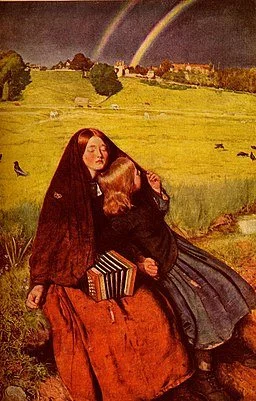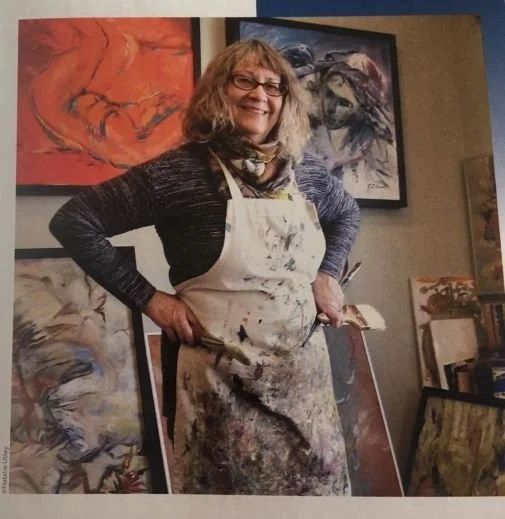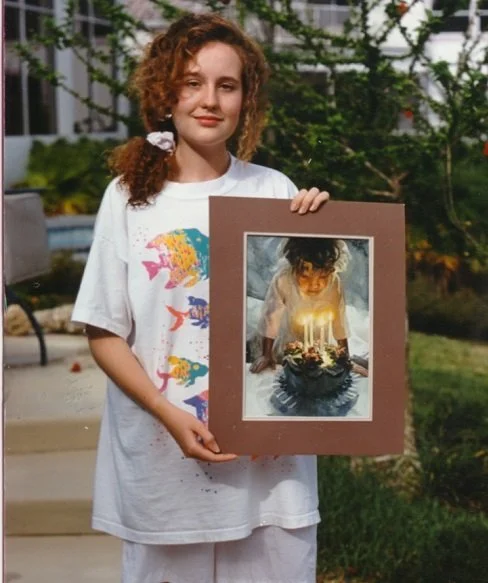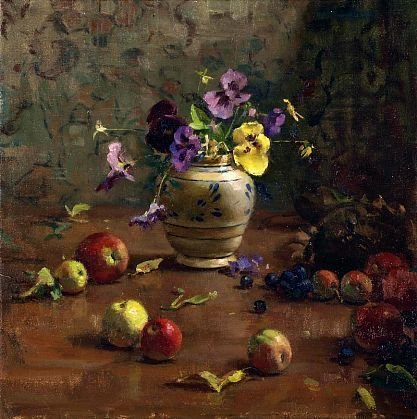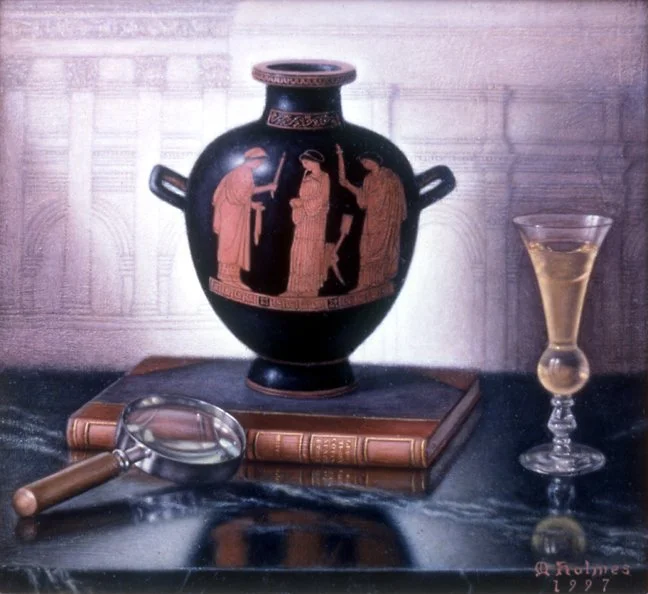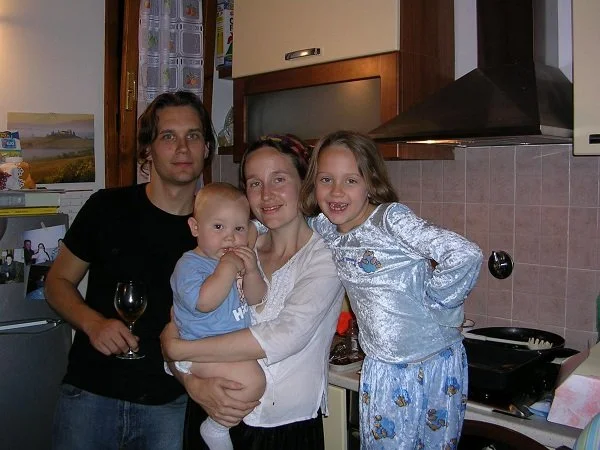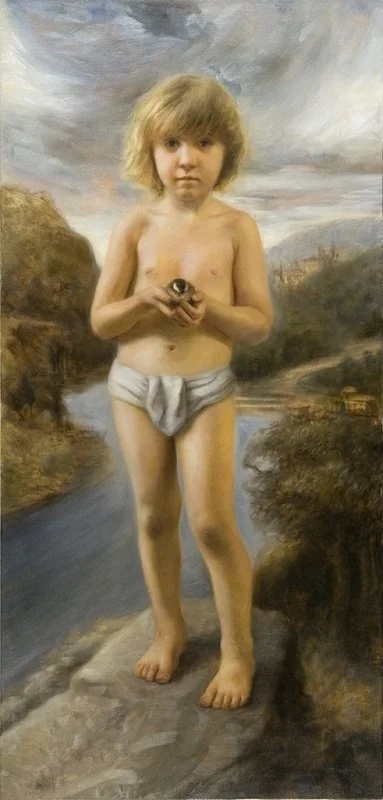What's the Story Behind Thimgan’s Art?
Stories enrich our experience.
Once a painting or art piece has pulled me in by its visual appeal, the provenance story is the next most important aspect of experiencing art for me.
Me in 1975, Marquette, Michigan
I enjoy reading about the lives of artists and finding interesting intersections in their lives and social circles. Take the Pre-Raphaelites or Impressionists (any school of art) and we discover painters, sculptors, poets, writers and musicians who mingled and influenced one another.
By owning a Thimgan Hayden original, you are participating in an art lineage, a provenance story, that will outlive us both.
Below, I am sharing a small bit of my own artistic biography. If this sort of thing bores you, read no more. But if you’re curious about how the tapestry of my life has been woven, and who some of my mentors and art friends are, read on!
I come from an artistic family. My maternal grandfather was the first one to start painting and sculpting. While I was growing up, my mom, dad, aunt and uncles all were actively creative, some as professionals (Jerry Dodd, Elsie Stewart). My cousin, Natalie (Stewart) Utley is also a painter. Art making was praised and encouraged in my family.
In the first grade and through early elementary school, I returned again and again to my mom’s book on the Pre-Raphaelites and another art history book that featured a particular portrait of a man with a blue sleeve (Portrait of Gerolamo Barbarigo in the Tate Collection) by Titian and The Blind Girl as well as The Bridesmaid (the model looks just like my mom did, maybe that fascinated me?) by Sir John Everett Millais.
The Blind Girl by J.E. Millais
The Bridesmaid by J.E. Millais
I drew a lot for fun when young, and as a young teen I went to an adult watercolor workshop with my mom and aunt in Spokane, Washington, taught by the well-known watercolor artist Stan Miller. At the same time, my talented Aunt Elsie (artist E.L. Stewart) began setting up still lifes for me, and teaching me the basics of realism, and my mom also inspired and coached me. While on my mother’s side I had the closer ties to active artists, my father’s side included a great uncle, Bill Borough, who was a serious watercolor artist selling work in Florida. He took my art ambition seriously and went out of his way to check on my early progress and encourage me. By the time I was seventeen, I was teaching watercolor classes to adults and other teens. I sold several watercolors of children and draft horses, and had a few pieces in a gallery in Appleton, Wisconsin (US) before switching to oil painting at the age of twenty.
College lasted one year for me, I was in a commercial art program in Florida and did not feel it was a good match. Computers were just becoming essential in graphic design and illustration and I wanted to be a gallery painter or pencil-holding illustrator.
Home again, I began oil painting and immersing myself in any materials from Atelier Lack and the Minnesota atelier group. I also took a painting workshop with Gregg Kreutz around this time, which forced me to paint a portrait from life as well as a still life (which I had avoided to this point). Another workshop attendee, Robert James, and I began a lifelong friendship and correspondence. The direct impact upon my creative life is that, over the thirty years that followed, Robert has gifted me an amazing art book library, book by book!
I also began corresponding with Joseph Ruppert, who would prove to be my soulmate and lifelong love.
Me in Florida looking 15 but being 20 with a watercolor. Smile.
I went to Maine and happened to meet American painter Abbott Thayer’s granddaughter (or niece? I cannot remember now) who married a family friend. While living there, I also got to see the Helga Exhibit there at the Wyeth Museum. The Wyeths, all of them, always impressed me.
Me in Maine in front of what was my first oil portrait commission (the lovely Dori Vermette and son)
Joseph and I (now married) moved back to Spokane where I sold work through the Douglas Gallery, but I wasn’t content. I wanted to gain more skills. I wanted confidence. I was happy to be invited to the accomplished artist, Delbert (and wife Marjorie) Gish’s home and studio. I was blown away by Del’s work and although he was no longer teaching, he allowed us several visits to his home and studio. He and Joseph both were Russian literature fans, so we talked about more than art. Gish had studied with David Leffel (American) and (Ukrainian born) painter Sergei Bongart.
One of Delbert Gish’s still lifes
Another exciting master artist soon settled in Spokane, Melville Holmes. It was Melville’s desire to create paintings that felt like cherished friends, “works of contemplation” and that really struck a chord with me. I had recently hit a wall with my technique and was frustrated, wanting to understand how to work in layers and get more depth in my work. Melville is not only a beautiful painter, he is a materials expert, and opened a world of inquiry for me.
I began longing for a European education and, thanks to the support of my family, I enrolled at The Angel Academy of Art. I studied drawing in the atelier tradition that had been passed down from the French Academy. This combined with Michael John Angel’s firsthand knowledge learned from his master, Pietro Annigoni. During the 1960’s and 70’s, a handful of artists (many of them from the Minnesota atelier schools) sought out students of French-trained painters like R. H. Ives Gammell (who had studied with William Paxton, a direct student of the French Academie), to learn from these last legacy bearers. Art for art’s sake and Modernism were dangerously close to obliviating a vast store of technical knowledge in its effort to revolt against the political and, yes, often distasteful art world gate-keeping. Several young Americans chose to study in Florence, Italy, with Pietro Annigoni (b. 1910 d. 1988), a teacher who himself had learned at the Accademia di Belle Arti di Firenze.
A self portrait by Pietro Annigoni
Painting at Santo Spirito on my free time.
“Nicoletta” by Thimgan Hayden (a charcoal draw from a live model) 2004, Collection of Fred and Sherry Ross
Studying in Florence was a rich experience for me, really for our little family. Valuable insights and treasured moments were not isolated to what I was learning at The Angel Academy. Times were changing rapidly. The US was at war in Iraq, the Euro currency began gaining strength against the dollar, and we had just welcomed our second child. Now we knew I would not be able to stay for a full painting program, but that was okay. I attended history lectures by Charles Cecil, took a really helpful workshop from Leo Hresko-Mancini and Jura Bedic, and took a bus out to the Tuscan village of Caldine to learn about paint chemistry and pigment grinding from the impressive Adrian Gottlieb. He was just about ready to return to the US and begin his career.
Our little family in our 2nd Florence flat 2005. Our daughter’s Italian speaking proficiency exceeds mine.
Two fellow art student friends directly influenced my approach to drawing and painting (as well as just being really awesome friends).
Clemens Fuchs (Austrian) frequently dined with our family, and during the summer, we did portraits from life of one another and he showed me, not what the Angel Academy teaches, but the techniques passed down in his family, from his prominent father, Michael Fuchs, and grandfather Ernst Fuchs (a founder of the Vienna School of Fantastic Realism). What Clemens taught me is closest to the portrait technique that I use most often for studio pieces. It remains the most natural process for me.
Jonathan Sherman (American) now has a wonderful studio in Marble Head, Massachusetts. We have enjoyed a long-running discourse on oil painting methods and found we were simpatico in our passion for old techniques and the philosophical aspects of painting and still keep in touch.
My portrait of Clemens Maria Fuchs
After completing the Drawing Course at the Angel Academy, I began painting independently at Rebecca Harp’s Studio in the Piazza del Republica as a way to unpack all I’d learned so far and start combining methodologies and make something “my own''. During that year, Rebecca kindly invited me to exhibit with her and a couple of other women painters at the studio. Among the several distinguished artists in Florence who attended the Opening, were Richard Maury, who introduced himself, which completely thrilled me (Read this fantastic interview with Mr. Maury here- https://asllinea.org/richard-maury-interview/), and Richard Serrin. Richard Serrin invited me to his home and studio to show me his experiments with mediums and their profound effect on texture. He was deeply fascinated with Rembrandt’s technique.
L to R - Rebecca Harp (USA), Malin Stromberg (Sweden), Sharon Okun (Canada) and me
A close friend of one of Annigoni’s inner circle was walking his dog one day and found me landscape painting and kindly invited me to the artist Romano Stefanelli’s studio. There were frescoes everywhere, casts, and huge paintings galore. It was incredible! It was a glimpse into the deeply historical local art life of the great city.
I have been fortunate to meet many more fascinating artists than I can mantion here, but I have a cool photo of this particular opportunity. For the sake of brevity, I am leaving out names of very dear friends, many of whom have gone on to earn fantastic international reputations. I’m proud to know them because they are wonderful, kind people doing amazing work.
My visit to Stefanelli’s studio (seated) 2007
Coming back to the States, we settled in Michigan (where my extended family has lived for generations). We lived for several years in Saugatuck/Douglas, called the Art Coast of Michigan and for good reason. This small community pulls together art lovers from Detroit, Chicago and Grand Rapids and beyond that, the world. It’s a terrific place! I had my own studio gallery for a year (I knew nothing about running a business and it was 2007- an economic disaster).
I taught, and saw some of my artwork go into wonderful homes and a few prestigious collections in the US and the UK.
I had the eye-opening experience of world travelers come in and cry at how beautiful and soulful my paintings were, only to be followed by a local telling me that I should watch more TV painters to improve my techniques. Go figure.
my studio in Douglas, Michigan 2008
Cedric and Chickadee - a study in innocence
painting the piazza in Montefiascone, Italy 2012 Residency with Artegiro
Life is an adventure! My life is woven with the colorful threads of so many people. In a time when I often feel alone in grieving the passing of some of old ways of connecting and making paintings, I sincerely take joy in the chance meetings, friendships and life experiences that contribute to making me who I am and my work unique in ways that go beyond technique.
I hope you found this interesting. Maybe you, like me, are overwhelmed by all the wonderful people and small miracles that have changed your life for the better. I do hope so! and I’d love to hear about it!


